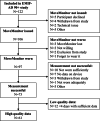Physical activity levels in cognitively normal and cognitively impaired oldest-old and the association with dementia risk factors: a pilot study
- PMID: 36882690
- PMCID: PMC9993554
- DOI: 10.1186/s12877-023-03814-4
Physical activity levels in cognitively normal and cognitively impaired oldest-old and the association with dementia risk factors: a pilot study
Abstract
Background: Research assessing the relationship of physical activity and dementia is usually based on studies with individuals younger than 90 years of age. The primary aim of this study was to determine physical activity levels of cognitively normal and cognitively impaired adults older than 90 years of age (oldest-old). Our secondary aim was to assess if physical activity is associated with risk factors for dementia and brain pathology biomarkers.
Methods: Physical activity was assessed in cognitively normal (N = 49) and cognitively impaired (N = 12) oldest-old by trunk accelerometry for a 7-day period. We tested physical performance parameters and nutritional status as dementia risk factors, and brain pathology biomarkers. Linear regression models were used to examine the associations, correcting for age, sex and years of education.
Results: Cognitively normal oldest-old were on average active for a total duration of 45 (SD 27) minutes per day, while cognitively impaired oldest-old seemed less physically active with 33 (SD 21) minutes per day with a lower movement intensity. Higher active duration and lower sedentary duration were related to better nutritional status and better physical performance. Higher movement intensities were related to better nutritional status, better physical performance and less white matter hyperintensities. Longer maximum walking bout duration associated with more amyloid binding.
Conclusion: We found that cognitively impaired oldest-old are active at a lower movement intensity than cognitively normal oldest-old individuals. In the oldest-old, physical activity is related to physical parameters, nutritional status, and moderately to brain pathology biomarkers.
Keywords: 90+; Brain pathology; Cognitively impaired; Physical performance; Physically active.
© 2023. The Author(s).
Conflict of interest statement
The authors do not report any competing interests.
Figures



References
-
- World Health Organization. Ageing and health. 2018 03 September 2020]; Available from: https://www.who.int/news-room/fact-sheets/detail/ageing-and-health
-
- Ramsey KA, Meskers CG, Maier AB. Every step counts: synthesising reviews associating objectively measured physical activity and sedentary behaviour with clinical outcomes in community-dwelling older adults. The Lancet Healthy Longevity. 2021;2(11):e764–72. doi: 10.1016/S2666-7568(21)00203-8. - DOI - PubMed
-
- Tolley AP, Ramsey KA, Rojer AG, Reijnierse EM, Maier AB. Objectively measured physical activity is associated with frailty in community-dwelling older adults: A systematic review.Journal of clinical epidemiology. 2021. - PubMed
-
- Ramsey KA, Rojer AG, D’Andrea L et al. The association of objectively measured physical activity and sedentary behavior with skeletal muscle strength and muscle power in older adults: A systematic review and meta-analysis.Ageing research reviews. 2021:101266. - PubMed
-
- Bann D, Hire D, Manini T, et al. Light intensity physical activity and sedentary behavior in relation to body mass index and grip strength in older adults: cross-sectional findings from the Lifestyle Interventions and Independence for Elders (LIFE) study. PLoS ONE. 2015;10(2):e0116058. doi: 10.1371/journal.pone.0116058. - DOI - PMC - PubMed
Publication types
MeSH terms
Grants and funding
LinkOut - more resources
Full Text Sources
Medical

